If you’re looking for some great board games for 3 year olds, you’re in the right place!
Board games are a fun way to engage young children while helping them to learn new skills.
And in this article we’ll highlight some of the best board games out there for 3 year olds that are both kid and parent approved.
To be clear, these are games that are actually designed to be at the level of a 3 year old, not just games for older kids that 3 year olds can muddle through as well. That being said, many of these games are ones that you can play as a family and everyone can enjoy together.
Read on for engaging, entertaining games that your child will want to play over and over again.
Be sure to also check out our lists of board games for 2 year olds and board games for 4 year olds!
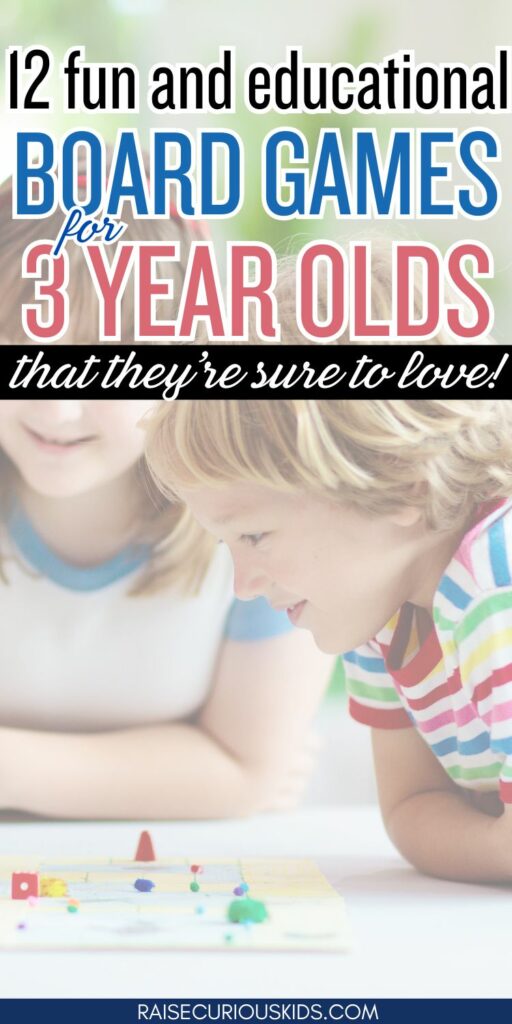
Board Games for 3 Year Olds
The Sneaky Snacky Squirrel

Number of players: 2-4
Up first is one of our 3 year old’s very favorite games, The Sneaky Snacky Squirrel.
This game combines elements of strategy, fine motor skills, and color recognition in a fun and interactive setting. The game’s premise revolves around a hungry squirrel on a quest to collect acorns of various colors.
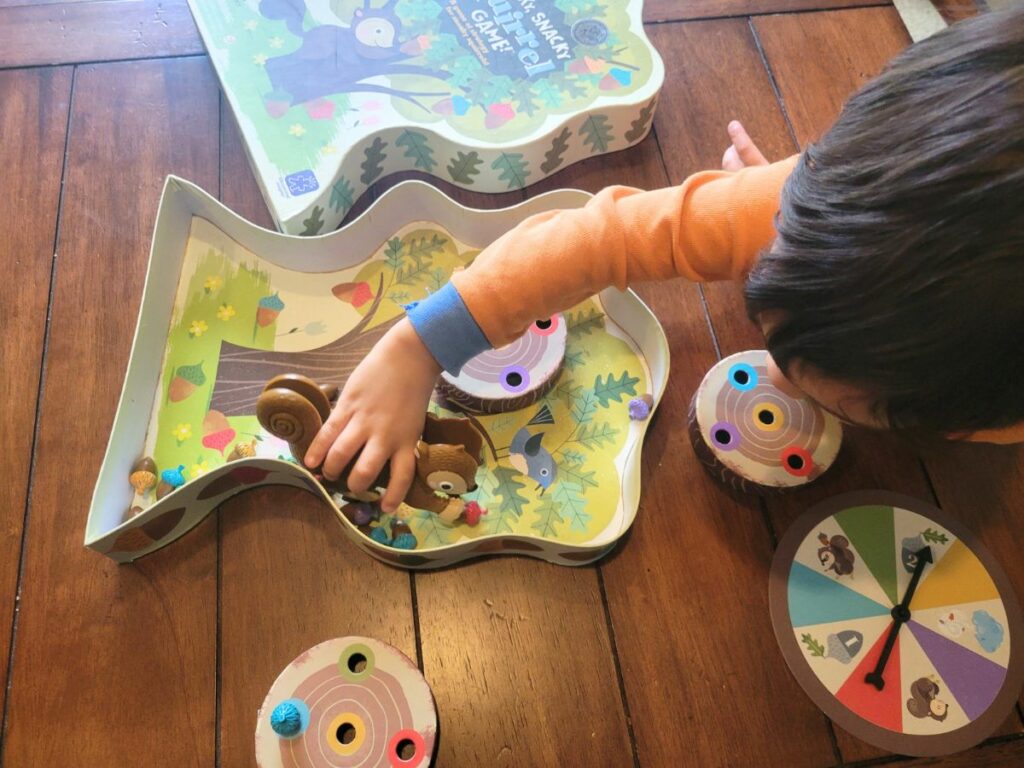
Players take turns spinning the spinner and using a set of squirrel-shaped tweezers to pick up acorns of the corresponding color. The objective is to fill their respective logs with an acorn of each color. While you play you have to watch out for the “lose an acorn” and “steal an acorn” spaces on the spinner. Whoever collects each color of acorn first wins!
Not only is this game entertaining, but also introduces basic concepts like color recognition and matching.
Our family loves playing this game. It’s engaging enough that our older kids like playing it but simple enough that our 3 year old can be right there in the mix!
Friends and Neighbors

Number of players: 1-4
Peaceable Kingdom’s “Friends and Neighbors” is a cooperative board game designed specifically for young children. The game focuses on social-emotional development, empathy, and teamwork.
In the game, each player gets a board with nine characters on it, each character having a different problem. Then they draw a token from the bag and match the token to the character their token could help. For example, a ladder for a cat stuck in a tree and a bottle for a crying baby.
The objective is for players to identify and understand what the characters are feeling and what they need, fostering empathy and emotional intelligence.
The cooperative nature of the game encourages players to collaborate rather than compete. This not only promotes teamwork but also helps young children develop important social skills such as communication and cooperation.
Friends and Neighbors is often praised for its educational value in introducing emotional awareness and social skills in a playful and interactive way, making it a popular choice among parents and educators.
Feed the Woozle

Number of players: 2-5
Feed the Woozle is a cooperative Peaceable Kingdom board game designed for young children.
In this game players work together to feed a hungry creature called the Woozle. The game has a few different variations so you can make it more challenging as your child gets older.
At the basic level, you roll the die to determine how many snacks to put on your spoon and then try to balance the snacks as you place them in the Woozle’s mouth. You can move the Woozle further away as your child gets better at balancing the snacks so that they have further to walk.
After they’ve mastered that aspect, you can add in the spinner, which provides a special way to get to the Woozle, such as “walk backwards” or “bunny hop”.
The cooperative aspect of the game encourages teamwork and helps young children develop social skills.
This is a cute and silly game that young kids will be dying to play over and over again!
Snug as a Bug in a Rug

Number of players: 2-4
In Snug as a Bug in a Rug, players work together to help a variety of cute and colorful bugs get snug under the rug before the pesky stink bugs take over.
The game includes different levels of play, allowing it to be adjusted based on the developmental stage of the children.
At the beginning of the game, the die is rolled to determine if you will be matching based on color, shape, or number.
Players then take turns spinning the spinner and then trying to find a bug of the matching shape, number, or color. If you can’t find a match, a stink bug comes out!
The goal is to get all of the bugs under the rug before the three stink bugs arrive. This is a cooperative game, so everyone either wins together or loses together.
The cooperative nature of the game encourages teamwork and social interaction, making it an excellent choice for young children who are still developing these skills.
SEQUENCE for Kids

Number of players: 2-4
SEQUENCE for Kids is a children’s version of the popular family card and board game SEQUENCE. This kids version retains the essence of the original game but simplifies it to suit younger players.
Players take turns playing an animal from their hand and placing a chip on a corresponding animal on the board. Unicorns act as a wildcard and dragons allow you to remove another player’s chip. The goal is to form a sequence of four of your chips in a row on the game board.
The game promotes strategic thinking as children decide where to place their chips and try to block opponents from forming their sequences. It also encourages pattern recognition, counting, and planning—all in a format that is engaging and entertaining for younger players.
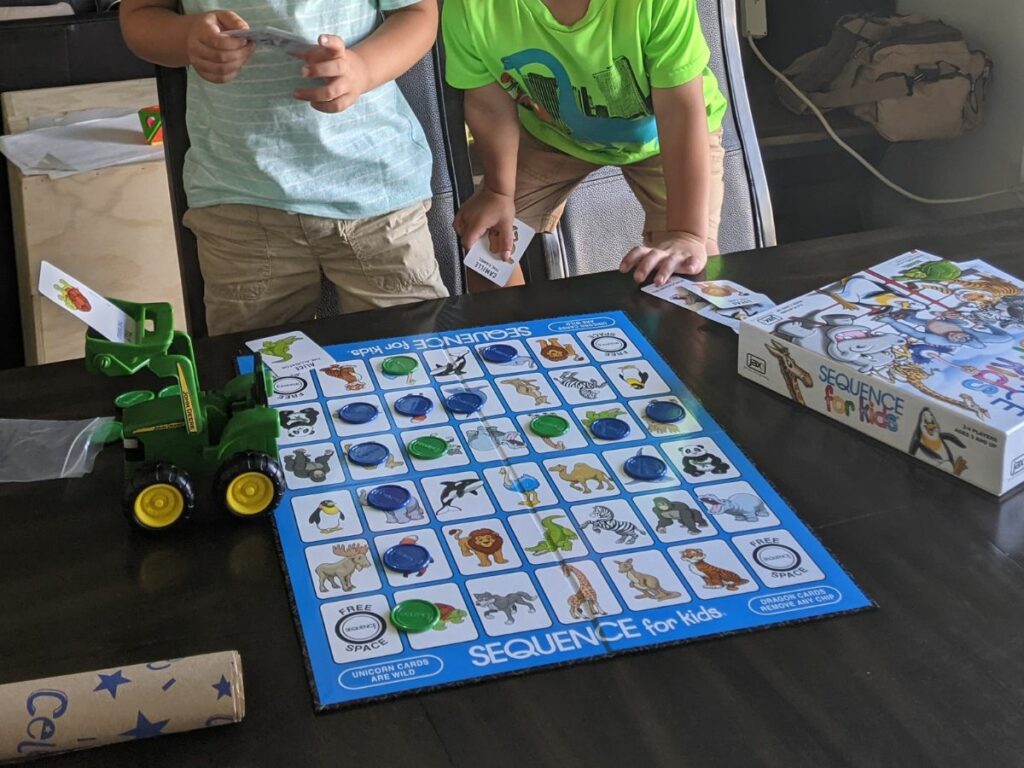
And because it uses pictures instead of words, this is a great game to include pre-readers.
SEQUENCE for Kids is a family-friendly game that bridges the gap between preschoolers and older siblings or adults, providing a shared gaming experience for the whole family. We love this game because all three of our kids (ages 3 to 7) can play this game together and have a great time! And it’s a game that’s actually fun for adults to play too!
Ants in the Pants

Number of players: 2-4
Ants in the Pants is a classic children’s dexterity game that has been updated for the next generation.
The game features a plastic “pants” container, shaped like a pair of trousers. The objective of the game is for players to launch colorful ant-shaped game pieces into the pants. The winner is the first player to successfully get all of their ants into the pants.
Ants in the Pants is a game that combines elements of fine motor skills, hand-eye coordination, and a touch of luck.
Kids will get a kick out of the concept of launching ants into the panda’s pants and parents will enjoy playing too! It’s a game that not only entertains but also helps develop basic motor skills in a fun and interactive way.
Shelby’s Snack Shack

Number of players: 2-4
In Shelby’s Snack Shack, players join a cute dog named Shelby as they help her find and collect bones on the beach.
Spin the spinner to find out how many bones Shelby needs to collect and then use the adorable Shelby tongs to place that many bones in your bowl. Whoever collects the most bones wins.
The primary focus of the game is on early math skills, including counting, addition, and subtraction.
The pieces are sturdy and hefty, making them durable and perfect for little hands.
This board game not only provides an entertaining experience but also serves as a valuable tool for introducing and reinforcing early math skills and promoting fine motor skills and dexterity.
Busy Town Eye Found It

Number of players: 2-4
One of our very favorite board games for 3 year olds is Busytown Seek and Find!
Based on the beloved children’s book series by Richard Scarry, Busytown Seek and Find Game brings the Busytown world to life in a seek-and-find adventure.
The game features a jumbo-sized colorful game board depicting the bustling and vibrant Busytown.
Players spin the spinner to determine if they’ll move forward, draw a card, or if the pigs will eat an item of food. The cards have different items on them and you have until the sand timer runs out to find as many on the game board as possible (eg. balloon, shovel, traffic cone). When you find an item, you place a miniature magnifying glass over it (my kids love this part!)
If the pigs eat all the food before all of the players make it to the end of the board, everyone loses. If you make it there first, everyone wins together!
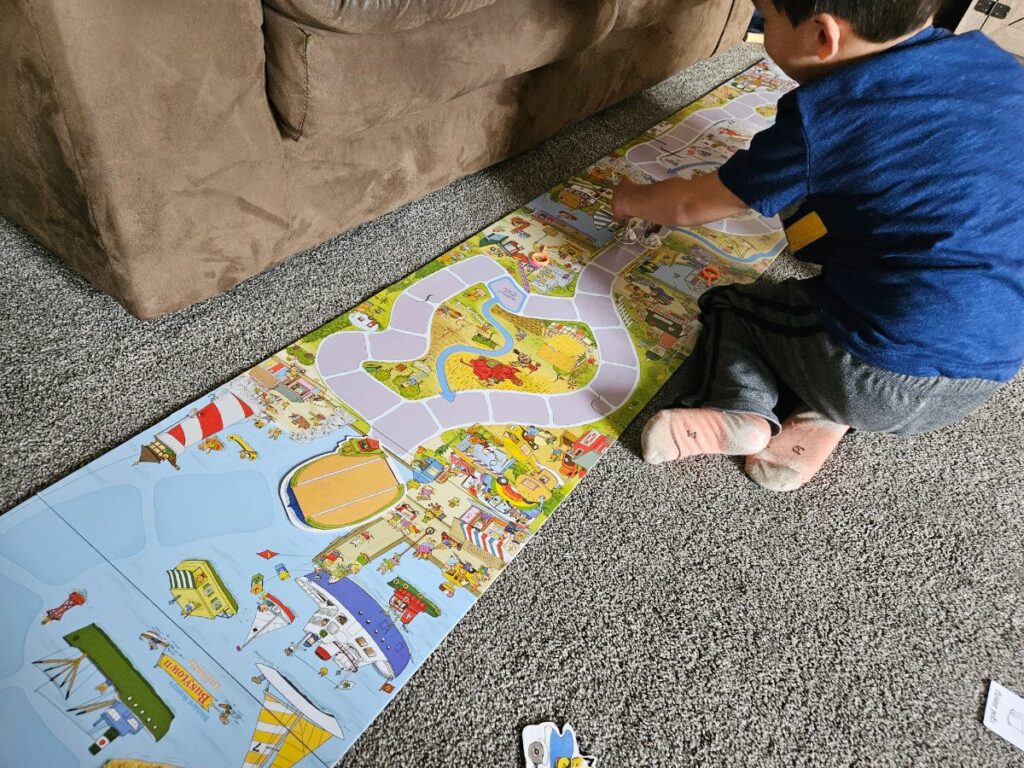
My kids absolutely love this game and it’s one of my favorite games to play with them because I actually enjoy playing it too! It’s a fun game combined with the lovable characters and illustrations from the beloved book series.
Raccoon Rumpus

Number of players: 2-4
Raccoon Rumpus is a fun and engaging matching game designed for preschoolers.
The objective of the game is for players to collect costumes for their raccoons by rolling two dice, a color die and a clothing die, and then picking a costume that has the corresponding piece. The first player to collect five costume wins.
Raccoon Rumpus is designed to be accessible to young children, with simple rules and engaging components.
The colorful and whimsical illustrations, along with the tactile nature of the game, make Raccoon Rumpus an enjoyable and educational experience for preschoolers. It provides a fun introduction to early math skills while incorporating elements of imaginative play and creativity.
Pete the Cat Missing Cupcakes Board Game

Number of players: 2-4
Based on the popular book series, Pete the Cat Missing Cupcakes Board Game allows kids to immerse themselves in the world of Pete the Cat!
In this game, players work together to help Pete and his friends get the missing cupcakes back from Grumpy Toad.
Spin the spinner to determine how many spaces to move, then complete a task to get a cupcake back from Grumpy Toad! Tasks include activities such as singing a song, identifying a letter or animal, or acting something out.
This is a fun cooperative game that fans of Pete will love playing!
Hi Ho Cherry Oh!

Number of players: 2-4
Hi Ho! Cherry-O is a classic children’s board game that has been enjoyed for generations.
The objective of “Hi Ho! Cherry-O” is for players to pick the fruit from their trees and place them in their baskets. Players take turns spinning a spinner, and the number indicated on the spinner determines how many pieces of fruit they can pick.
If you land on an animal, the animal eats the fruit and you have to put it back on the tree. If you land on the spilled bucket you have to put all of the fruit that you’ve picked back on the tree. The first person to get ten pieces of fruit wins!
The simplicity of the rules and the colorful design make “Hi Ho! Cherry-O” accessible and entertaining for young children, helping them develop counting and basic math skills in a fun and interactive way.
Sunny and Stormy Day

Number of players: 1-3
Sunny and Story Day is a cooperative game that helps children gain emotional intelligence as they talk about the ups and downs that can happen in a given day.
The game comes with a book where you can read about Max the Hedgehog’s sunny and stormy day. After reading, play a matching game to pair up the sunny and stormy events of Max’s day before the moon comes up.
Also included is a sharing game, where you draw a token from the pouch and take turns sharing the stormy and sunny parts of your own day.
This game is a great way to teach children to identify their emotions and talk about their feelings.
What to look for in a board game for a 3 year old
When selecting board games for 3-year-olds, it’s important to consider their developmental stage and choose games that align with their abilities and interests. Here are some key factors to look for:
- Simple Rules: Opt for games with straightforward and easy-to-understand rules. 3-year-olds are still developing their cognitive abilities, so games with minimal and uncomplicated instructions will keep them engaged without overwhelming them.
- Large and Durable Pieces: Toddlers can be a bit rough on their belongings, so choose games made from durable materials that can withstand some wear and tear. Choose games with large, durable pieces that are easy for little hands to grasp and manipulate.
- Short Playtime: Attention spans are still developing at this age, so look for games with relatively short play durations. Quick rounds maintain the child’s interest and allow them to experience the satisfaction of completing a game.
- Engaging Themes: Select games with themes that resonate with a 3-year-old’s interests. Whether it’s animals, colors, shapes, or familiar characters, a captivating theme enhances the appeal of the game.
- Interactive Elements: Board games that involve movement, sound, or tactile interactions can be particularly engaging for toddlers. Games with spinning dials, buttons to press, or pieces to place on a board provide a sensory-rich experience.
- Cooperative Play: Consider games that encourage cooperative play rather than competitive play. This fosters a sense of teamwork and reduces potential frustration associated with winning or losing.
- Educational Value: Look for games that incorporate educational elements, such as basic counting, color recognition, or shape matching. These games can contribute to early learning in a fun and interactive way.
By considering these factors, you can find a board game that not only entertains a 3-year-old but also supports their development in a safe and age-appropriate manner.
Benefits of board games for 3 year olds
Since you’re here looking for a board game for a 3 year old I’m probably preaching to the choir here, but there are so many reasons why playing board games is not only fun for 3 year olds, it’s actually good for them! Here’s just a few of the benefits of playing board games with your 3 year old.
- Cognitive Development: Playing board games helps enhance cognitive skills such as memory, attention, and problem-solving as children learn to follow rules and make decisions.
- Social Skills: Board games promote social interaction, teaching young children how to take turns, share, and cooperate with others.
- Language Development: Many board games involve verbal communication, which contributes to the development of language skills. Children learn to express themselves, listen to others, and follow instructions.
- Fine Motor Skills: Moving game pieces, rolling dice, or picking up cards can improve fine motor skills and hand-eye coordination in young children.
- Math Skills: Some board games involve counting spaces, recognizing numbers, or understanding basic mathematical concepts, providing an early introduction to math skills.
- Patience and Sportsmanship: Board games teach children the importance of patience and how to handle both winning and losing gracefully, fostering good sportsmanship.
- Creativity: Certain board games encourage imagination and creativity as children engage in imaginative play, storytelling, or strategic thinking.
- Attention Span: Playing board games helps improve attention span and concentration as children focus on the game rules and the actions of other players.
- Family Bonding: Board games provide an excellent opportunity for quality family time, fostering stronger bonds and creating lasting memories.

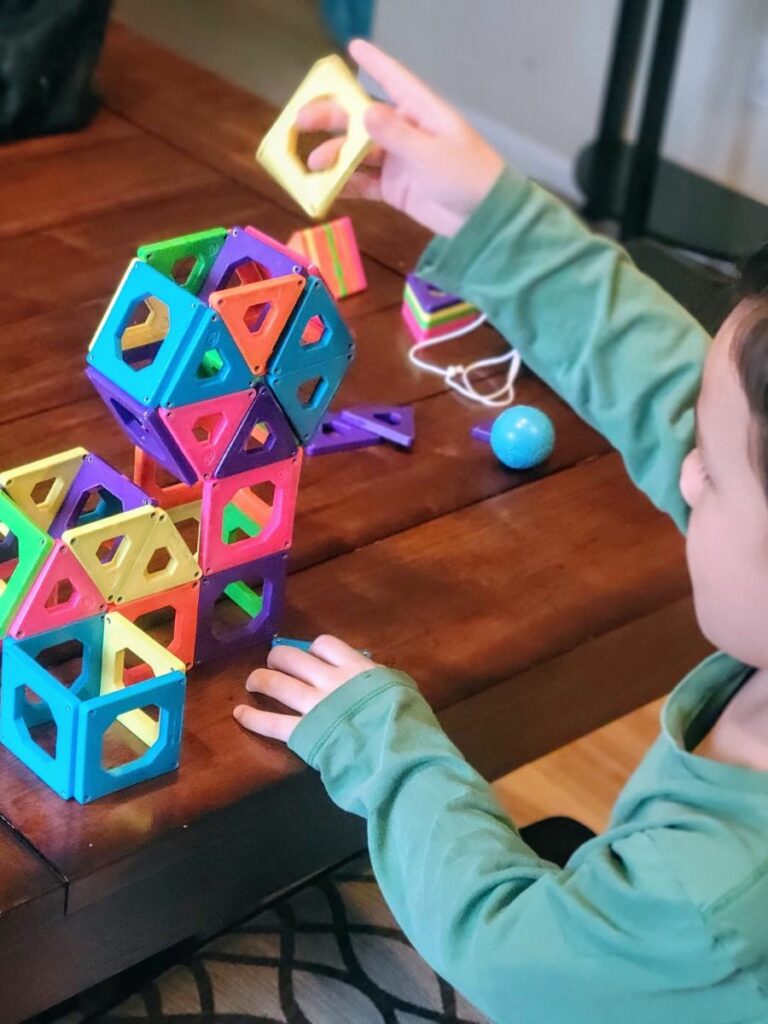

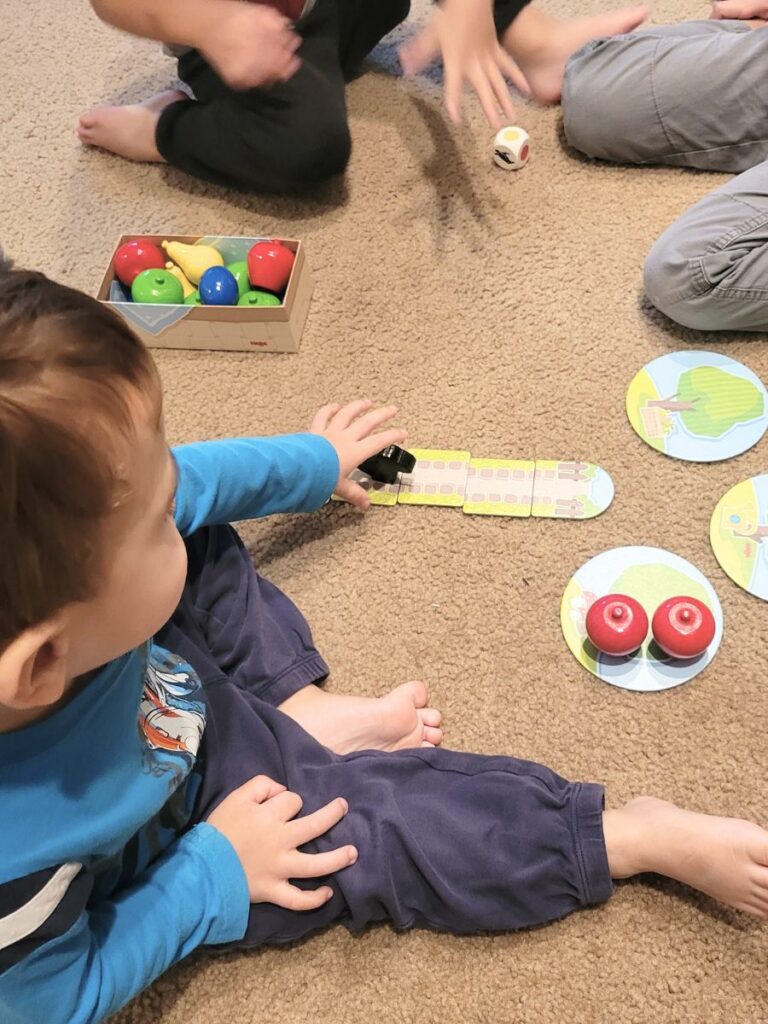

Pingback: Homepage
Pingback: seo for counselors
Pingback: ไฮเบย์
Pingback: bus ticket online
Pingback: Plinko
Pingback: กระดาษสติ๊กเกอร์ความร้อน
Pingback: aviator website
Pingback: Scott
Pingback: Dragon Hatch 2
Pingback: jili slot
Pingback: ราคาค่าหวย แทงไม่อั้น
Pingback: fear of god essentials
Pingback: magic mushroom gummies area52.com
Pingback: พากย์เสียงเลือกตั้ง
Pingback: ห้องพักรายเดือนศรีราชา
Pingback: fake lv bags
Pingback: หนังใหม่พากย์ไทย
Pingback: Ethical Elephant Sanctuary
Pingback: here
Pingback: Super Surface
Pingback: รับออกแบบ อพาร์ทเมนท์
Pingback: Learn more about Alexander Debelov
Pingback: รับจด อย
Pingback: กระเช้า
Pingback: aviator online game
Pingback: เว็บปั้มไลค์
Pingback: ร้านปริ้นเอกสาร
Pingback: ร้านตัดแว่นสายตา
Pingback: จัดหาแม่บ้าน
Pingback: ทำความรู้จัก bet365 ทางเข้า
Pingback: monixbet casino betrouwbaar of niet
Pingback: clothing manufacturer
Pingback: บริการพ่นฉนวนพียูโฟม
Pingback: sa789
Pingback: ktvvip
Pingback: #GoXScooters